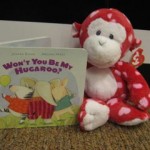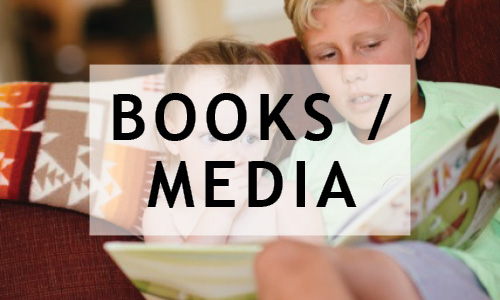 Hang out for day with a child, and you realize that Valentine’s Day is everyday–filled with love and hugs overflowing. Capture the spirit with a fun picture book, whether chasing a kiss through the forest, freely dispersing hugs through a carnival, or laughing out loud at Rapunzel’s new love twist. Take time to read and talk about the book, enriching your child’s experience as you expand on the story and relate it to your little one’s life.
Hang out for day with a child, and you realize that Valentine’s Day is everyday–filled with love and hugs overflowing. Capture the spirit with a fun picture book, whether chasing a kiss through the forest, freely dispersing hugs through a carnival, or laughing out loud at Rapunzel’s new love twist. Take time to read and talk about the book, enriching your child’s experience as you expand on the story and relate it to your little one’s life.
Babies and toddlers:
Won’t you Be My Hugaroo? By Joanne Ryder
Join this mom and tot zebra pair as they journey through the carnival, offering hugs tailored to their friends’ needs. A “calming hug,” “twirly hug,” or “cheer-up hug” are just what the pig, elephant or bunny needs to face the scary slide, the spin until you grin teacup ride or a lost balloon. Your toddler will feel the energy and love these pals share as they hug their way through the day in Won’t You Be My Hugaroo?
Language and Literacy Tips:
Name your hugs as you go through the day, teaching your toddler new vocabulary like “twirly,” “calming” or “excited hug” when you are anticipatingsome fun. Repeat the rhyming words, emphasizing the same final sounds—spin/grin, tight/delight, jiggle/wiggle—as you read. Children start to learn that words are made up of sounds. Recognizing rhyming establishes an order to the sounds, including beginning and end.
Guess How Much I Love You by Sam McBratney
This is a wonderful bedtime tale of a little one and his parent declaring the immensity of their love for one another. It’s hard to top Little Nutbrown Hare’s sizable love–as wide as his arms, as high as he can reach, or upside down up to his toes! But Big Nutbrown Hare’s love reaches even wider and higher, “right up to the moon.” The endearing illustrations tell the story too.
Language and Literacy Tips:
Add gestures to the story of Guess How Much I Love You for your little one. Gestures precede and parallel language development. Children enjoy imitating your pantomime of the story and learn to follow directions and imitate–just like they will soon be imitating your sounds and words. Make up your own love comparisons, “I love you as high as the lamp or the mirror or the tree outside–or as wide as the table, couch or driveway.” Adding to your child’s understanding of vocabulary will build their eventual oral vocabulary.
Counting Kisses by Karen Katz
Kiss your tired baby right to sleep, counting backwards as you plant a wet one on “teeny tiny toes,” “chubby, yummy knees,” or an “itty bitty nose.” Karen Katz’s vivid patchwork designs mesmerize babies as they unknowingly learn their numbers and body parts as well as yummy vocabulary through Counting Kisses.
Language and Literacy Tips:
Act out the book, counting your kisses, making up new lines to match your number of kisses to extend your story. Use a doll or stuffed animal to encourage your toddler to follow the directions of planting kisses. Children learn to follow directions (a 1 year-old typically follows 1 direction and a 2 year-old can follow 2 steps) and kissing sure makes it fun! This book also comes in a set that includes a kitty rattle with all the parts ready for a kiss.
Preschool Age and up:
Falling for Rapunzel by Leah Wilcox
When I was a little girl, I loved my well-worn collection of fables that included Rapunzel. I could recite, “Rapunzel, Rapunzel, let down your hair!” anticipating the love story that followed. You can imagine my interest in this version, Falling for Rapunzel, in whose clever rhyming couplets reveal a tale of confusion. Riding up to Rapunzel’s tower, the prince dutifully requested that she let down her hair. A princess who misheard each request, threw down underwear instead of hair, dirty socks instead of locks, dresses instead of tresses and and pancake batter instead of a ladder! A twist to the old tale, Rapuzel finally threw down her “maid” instead of her “braid” and they rode off happily ever after.
Language and Literacy Tips:
Add to the story making requests to throw something down (maybe items from her room—hat/cat, scarf/dog that went “Arf”) and match it with a rhyming mistake, just like the story. The sillier the better! Imagine a classroom of kids brainstorming on further funny misunderstandings. Talk about poetry since each page is a poem in itself. The best learning happens when kids are having fun and don’t know they are creating. Read the original fairy tale, make a chart and compare the two. This helps children learn the language of comparison.
The Kiss That Missed by David Melling
Hurrying to give a hasty goodnight kiss to his son, the King missed his prince, as the intended kiss blew right by and bounced out the window. The king commanded his royal knight, “Follow that Kiss!” Mounting his horse backwards, revealing a silly rip in his pants, the bungling knight took off through the dark, snowy forest in pursuit of the royal kiss. Coming upon a potentially frightening scene, the knight watched as the growly bears, swooping owls and hungry wolves were gently put to sleep by the swirling kiss as it passed through the branches. The kiss did it’s last magic on a gigantic, hungry dragon, and the knight returned the kiss in time for a final bedtime story. David Melling’s comedic illustrations, inThe Kiss That Missed, provide for lots of fun and commentary by kids.
Language and Literacy Building Tips:
After reading this story to a 2 year-old, we played a game of blowing a kiss, he catched it and threw it in different directions as I guessed it’s destination–“in the garage,” “under the table,” “out the door,” or “over a truck.” What a fun way to teach prepositions and enjoy re-telling the story with a new twist. Look for the detail in the pictures and talk about it. Find all the animals hiding in the snow scene, talk about what is goofy about the knight, look at all the pieces of the story that come together in the final bedtime story scene.
Hug Time by Patrick McDonnell
Jules, the kitten, created by Mutts cartoon artist, Patrick McDonnell, sets out to give the world a hug. Not to miss anyone, he made out a “Hug-To-Do-List” of best friends, butterflies, and buttercups. He sets sail to see the world–Africa, India, the Rain Forest and the North Pole–distributing hugs of kindness to all he meets. A tale of loving our world and all that is in it, this book gives the littlest ones a bigger message of caring for our planet.
Hug Time can be read as a simple story to a toddler, or used with an older child to launch a discussion or writing activity about environmental issues. Look up a “babobob” tree and see what it is like. Talk about endangered species and what we can do to protect these animals.



